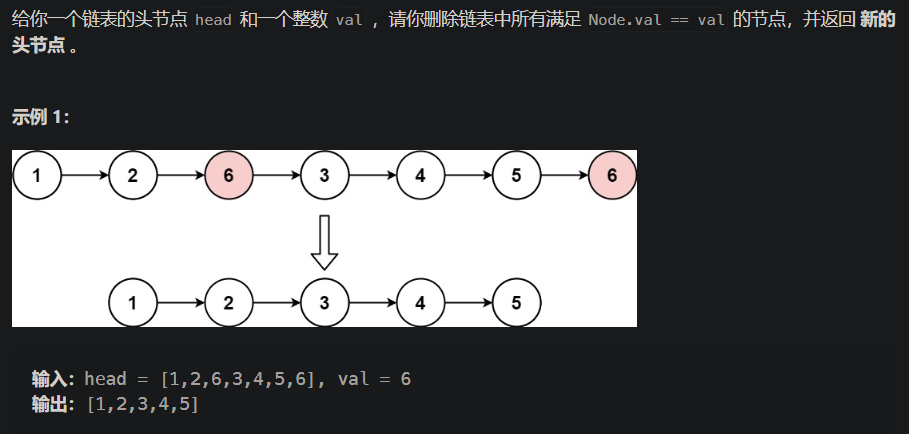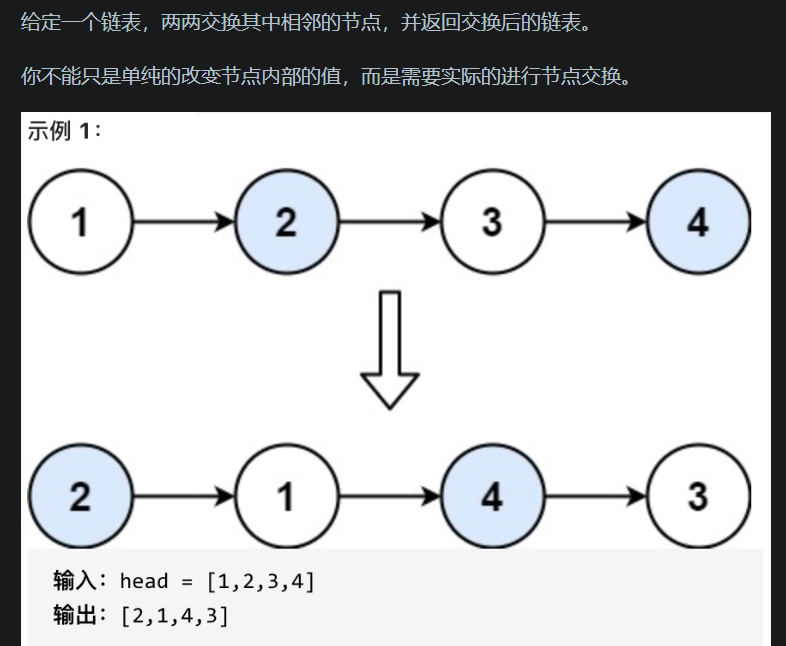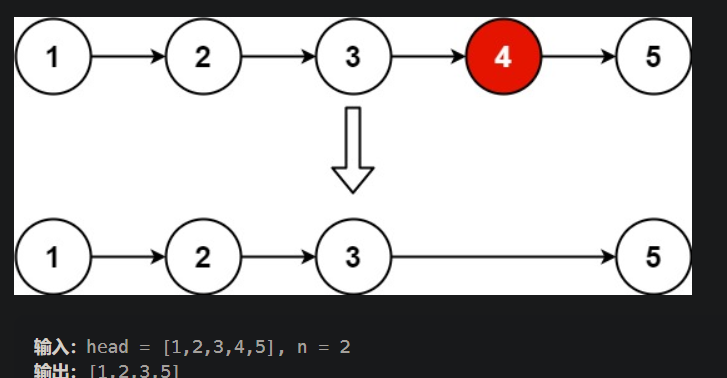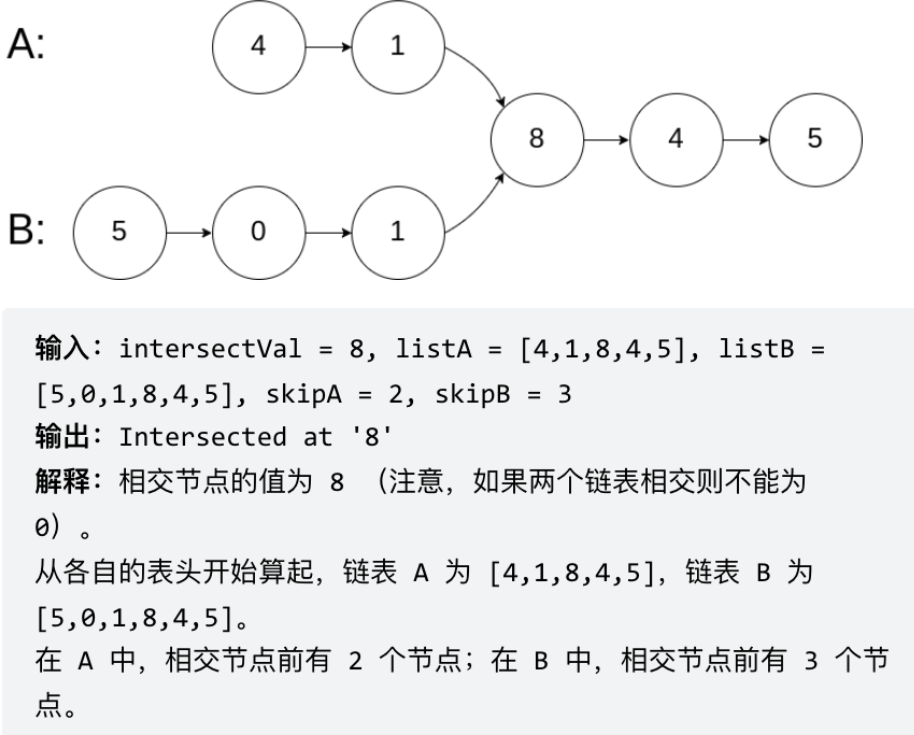系列综述:
💞目的:本系列是个人整理为了
秋招算法
的,整理期间苛求每个知识点,平衡理解简易度与深入程度。
🥰来源:材料主要源于
代码随想录
进行的,每个算法代码参考leetcode高赞回答和其他平台热门博客,其中也可能含有一些的个人思考。
🤭结语:如果有帮到你的地方,就
点个赞
和
关注一下
呗,谢谢🎈🎄🌷!!!
🌈
数据结构基础知识总结篇
一、链表理论基础
链表的定义
-
单链表数据结构
-
链表由
值
和
下一个节点指针
组成 -
成员初始化构造函数
,如果不定义,C++也会进行默认生成
struct listNode{ int val; listNode *next; listNode(int x):val(x), next(NULL){} } -
链表由
移除链表元素
-
链表基本操作
- 添加虚拟头节点vHead,统一遍历操作。
- 删除链表中的节点,不要忘记delete释放
-
题目

/** * Definition for singly-linked list. * struct ListNode { * int val; * ListNode *next; * ListNode() : val(0), next(nullptr) {} * ListNode(int x) : val(x), next(nullptr) {} * ListNode(int x, ListNode *next) : val(x), next(next) {} * }; */ ListNode* removeElements(ListNode* head, int val) { // 定义虚拟头节点 ListNode *vHead = new ListNode(0, head); ListNode* cur = vHead;// 定义工作指针cur while(cur->next != nullptr){ if(cur->next->val == val){// 为了获取操作节点的前一个节点进行删除 ListNode* tmp = cur->next; cur->next = cur->next->next; delete tmp; }else{ cur = cur->next;// 工作指针++ } } // 删除头节点 head = vHead->next; delete(vHead); return head; }
实现链表相关函数
- 相关题目
实现 MyLinkedList 类:
- MyLinkedList() 初始化 MyLinkedList 对象。
- int get(int index) 获取链表中下标为 index 的节点的值。如果下标无效,则返回 -1 。
- void addAtHead(int val) 将一个值为 val 的节点插入到链表中第一个元素之前。在插入完成后,新节点会成为链表的第一个节点。
- void addAtTail(int val) 将一个值为 val 的节点追加到链表中作为链表的最后一个元素。
- void addAtIndex(int index, int val) 将一个值为 val 的节点插入到链表中下标为 index 的节点之前。如果 index 等于链表的长度,那么该节点会被追加到链表的末尾。如果 index 比长度更大,该节点将 不会插入 到链表中。
- void deleteAtIndex(int index) 如果下标有效,则删除链表中下标为 index 的节点。
class MyLinkedList {
public:
// 定义链表节点
struct LinkNode{
int val;
LinkNode *next;
LinkNode(int val):val(val),next(nullptr){}
};
// 初始化头节点
MyLinkedList() {
vHead = new LinkNode(0);
size = 0;
}
// 根据索引值获取对应节点值
int get(int index) {
if(index < 0 || index > (size-1))
return -1;
// *****带头节点的索引值定位********
LinkNode* cur = vHead->next;
while(index--){
cur = cur->next;
}
// ************************************
return cur->val;
}
void addAtHead(int val) {
LinkNode* node = new LinkNode(val);
node->next = vHead->next;
vHead->next = node;
++size;
}
void addAtTail(int val) {
LinkNode* node = new LinkNode(val);
LinkNode *cur = vHead;
while(cur->next != nullptr){
cur = cur->next;
}
cur->next = node;
++size;
}
void addAtIndex(int index, int val) {
if(index > size) return;
if(index < 0) index = 0;
LinkNode* node = new LinkNode(val);
LinkNode* cur = vHead;
while(index--){
cur = cur->next;
}
node->next = cur->next;
cur->next = node;
size++;
}
void deleteAtIndex(int index) {
if(index < 0|| index >= size)
return ;
LinkNode *cur = vHead;
while(index--){
cur = cur->next;
}
LinkNode *tmp = cur->next;
cur->next = cur->next->next;
delete tmp;
size--;
}
private:
LinkNode *vHead;// 首地址
int size;// 大小
};
二、双指针
-
基本快慢指针
// 初始化快慢指针 int slow = 0; int fast = 0; // 快指针未超边界 while(fast < nums.size()){ if(nums[slow] == val){ doing(); ++slow; } ++fast; }
反转链表
-
头插法可以进行链表的反转
- 尽量使用明确的逻辑关系,减少变量的转换
- 先进行状态变量的状态保存,后进行逻辑处理
ListNode* reverseList(ListNode* head) { if(head == nullptr) return nullptr; // 头插法 ListNode* vHead = new ListNode(0); // 虚拟头节点 // 被遍历链表的工作指针 ListNode* cur = head; ListNode* hind; // 开始遍历 while(cur!= nullptr){ hind = cur->next;// 一定要确切的使用逻辑关系 // 头插法 cur->next = vHead->next; vHead->next = cur; cur = hind; } return vHead->next; }
交换相邻链表节点
-
letcode题目网址

ListNode* swapPairs(ListNode* head){ // 健壮性检查 if(head == nullptr) return nullptr; // 指向操作节点组的第一个和第二个 ListNode* prior_first; ListNode* prior_second;- // 增加虚拟头节点 ListNode* vHead = new ListNode(0); vHead->next = head; ListNode *cur = vHead; while(cur->next != nullptr && cur->next->next != nullptr){ prior_first = cur->next; prior_second = cur->next->next; prior_first->next = prior_second->next; prior_second->next = prior_first; cur->next = prior_second; cur = prior_second->next;// cur指向被操作节点组的前一个 } return vHead->next; }
删除链表的倒数第 N 个结点
-
letcode题目

ListNode* removeNthFromEnd(ListNode* head, int n) { if(n < 0 || head == nullptr) return nullptr; // 快慢指针拉开n个节点的距离 ListNode *vHead = new ListNode(0); vHead->next = head; ListNode *slow = vHead; ListNode *fast = vHead; // 让slow指向被删除节点的前一个 while(n--){ fast = fast->next; } // 同步移动 while(fast->next != nullptr){ fast = fast->next; slow = slow->next; } // 删除节点 slow->next = slow->next->next; return vHead->next; }
链表相交
-
letcode题目链接

ListNode *getIntersectionNode(ListNode *headA, ListNode *headB) { ListNode *curA = headA; ListNode *curB = headB; int lenA = 0; int lenB = 0; // 计算A和B的长度 while(curA != nullptr){ lenA++; curA = curA->next; } while(curB != nullptr){ lenB++; curB = curB->next; } curA = headA; curB = headB; // 求两链的差距 int dis = 0; if(lenA > lenB){ dis = lenA-lenB; while(dis--){ curA = curA->next; } }else{ dis = lenB-lenA; while(dis--){ curB = curB->next; } } // 同步移动判断指针 while(curA != curB){ if(curA == nullptr || curB == nullptr){ return nullptr; } curA = curA->next; curB = curB->next; } return curA; } -
有点东西的写法
ListNode *getIntersectionNode(ListNode *headA, ListNode *headB) { ListNode *A = headA, *B = headB; // 核心在于交换头节点 while (A != B) { A = A != nullptr ? A->next : headB; B = B != nullptr ? B->next : headA; } return A; }
链表相交
-
letcode题目链接
- 一个节点的next是否能访问,需要判断该节点是否存在
- 只写容易判断的逻辑,其他的交给else
ListNode *detectCycle(ListNode *head) { ListNode* slow=head; ListNode* fast=head; while(fast!=NULL&&fast->next!=NULL){ slow=slow->next; fast=fast->next->next; if(slow==fast){ slow=head; while(slow!=fast){ slow=slow->next; fast=fast->next; } return fast; } } return NULL; }
少年,我观你骨骼清奇,颖悟绝伦,必成人中龙凤。
不如点赞·收藏·关注一波
参考博客
版权声明:本文为qq_43840665原创文章,遵循 CC 4.0 BY-SA 版权协议,转载请附上原文出处链接和本声明。
